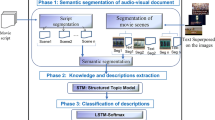Abstract
The descriptions of audiovisual documents used in the interrogation process should not be limited to the identification of some keywords selected from signal, or from the forms presented in the image. They should be however, extracted basically from the content whilst exploiting the knowledge conveyed in the document. In this context, the topic and thematic description represents important information from the content. This importance result from the effective presence of the documents’ content. Consequently, we concentrate efforts to propose a method that describe the theme and the topic of movies document based on the adaptation of the Latent Dirichlet Allocation (LDA) model by combining the textual and visual modalities from the pre-production movie document (Script) and from the superposed text in the image. The experiments results confirmed the interesting performance through two databases, namely, “Choi’s dataset” and our own created database from the Internet Movie Database Imdb (http://www.imdb.com/years2012/2013).
Access this chapter
Tax calculation will be finalised at checkout
Purchases are for personal use only
Similar content being viewed by others
References
Ferret, O., Grau, B.: A topic segmentation of texts based on semantic domains. In: ECAI, pp. 426–430 (2000)
Rahangdale, A., Agrawal, A.J.: Information extraction using discourse analysis from newswires. Int. J. Inf. Technol. Converg. Serv. 4(3), 21 (2014)
Azaiez, I., Ben Ahmed, M.: An approach of a semantic annotation and thematisation of AV documents. In: 2010 10th International Conference on Intelligent Systems Design and Applications (ISDA), pp. 1406–1411. IEEE (2010)
Chabi, A.H., Kboubi, F., Ahmed, Ben, M.: Thematic analysis and visualization of textual corpus. arXiv Prepr. arXiv1112.2071 (2011)
Deerwester, S.C., Dumais, S.T., Landauer, T.K., Furnas, G.W., Harshman, R.A.: Indexing by latent semantic analysis. JAsIs 41, 391–407 (1990)
Bellegarda, J.R.: A latent semantic analysis framework for large-Span language modeling. EUROSPEECH (1997)
Atkinson, J., Gonzalez, A., Munoz, M., Astudillo, H.: Web metadata extraction and semantic indexing for learning objects extraction. Appl. Intell. 41, 649–664 (2014)
Hofmann, T.: Probabilistic latent semantic indexing. In: Proceedings of the 22nd Annual International ACM SIGIR Conference on Research and Development in Information Retrieval, pp. 50–57. ACM (1999)
Blei, D.M., Ng, A.Y., Jordan, M.I.: Latent dirichlet allocation. J. Mach. Learn. Res. 3, 993–1022 (2003)
Dou, W., Wang, X., Skau, D., Ribarsky, W., Zhou, M.X.: Leadline: Interactive visual analysis of text data through event identification and exploration. In: 2012 IEEE Conference on Visual Analytics Science and Technology (VAST), pp. 93–102. IEEE (2012)
Vavliakis, K.N., Symeonidis, A.L., Mitkas, P.A.: Event identification in web social media through named entity recognition and topic modeling. Data Knowl. Eng. 88, 1–24 (2013)
Pahal, N., Chaudhury, S., Gaur, V., Lall, B., Mallik, A.: Detecting and correlating video-based event patterns: an ontology driven approach. In: Proceedings of the 2014 IEEE/WIC/ACM International Joint Conferences on Web Intelligence (WI) and Intelligent Agent Technologies (IAT)-Volume 01, pp. 438–445. IEEE Computer Society (2014)
Fourati, M., Jedidi, A., Gargouri, F.: Automatic identification genre of audiovisual documents. In: 2014 IEEE/ACS 11th International Conference Computer Systems Applied (AICCSA) (2014)
Fourati, M., Jedidi, A., Ben Hassine, H., Gargouri, F.: Towards fusion of textual and visual modalities for describing audiovisual documents. Int. J. Multimedia Data Eng. Manag. (IJMDEM) 6(2), 51–69 (2015)
Stockinger, P.: Audiovisual Archives: Digital Text and Discourse Analysis. John Wiley & Sons, New York (2013)
Choi, F.Y.Y., Wiemer-Hastings, P., Moore, J.: Latent semantic analysis for text segmentation. In: Proceedings of EMNLP. Citeseer (2001)
Ji, X., Zha, H.: Domain-independent text segmentation using anisotropic diffusion and dynamic programming. In: Proceedings of the 26th Annual International ACM SIGIR Conference on Research and Development in Informaion Retrieval, pp. 322–329. ACM (2003)
Utiyama, M., Isahara, H.: A statistical model for domain-independent text segmentation. In: Proceedings of the 39th Annual Meeting on Association for Computational Linguistics, pp. 499–506. Association for Computational Linguistics (2001)
Malioutov, I., Barzilay, R.: Minimum cut model for spoken lecture segmentation. In: Proceedings of the 21st International Conference on Computational Linguistics and the 44th annual meeting of the Association for Computational Linguistics, pp. 25–32. Association for Computational Linguistics (2006)
Misra, H., Yvon, F., Jose, J.M., Cappe, O.: Text segmentation via topic modeling: an analytical study. In: Proceedings of the 18th ACM Conference on Information and Knowledge Management, pp. 1553–1556. ACM (2009)
Beeferman, D., Berger, A., Lafferty, J.: Statistical models for text segmentation. Mach. Learn. 34, 177–210 (1999)
Hearst, M.A.: Multi-paragraph segmentation of expository text. In: Proceedings of the 32nd Annual Meeting on Association for Computational Linguistics, pp. 9–16. Association for Computational Linguistics (1994)
Yu, K., Li, Z., Guan, G., Wang, Z., Feng, D.: Unsupervised text segmentation using LDA and MCMC. In: Proceedings of the Tenth Australasian Data Mining Conference vol. 134, pp. 21–26. Australian Computer Society, Inc. (2012)
Author information
Authors and Affiliations
Corresponding author
Editor information
Editors and Affiliations
Rights and permissions
Copyright information
© 2015 Springer International Publishing Switzerland
About this paper
Cite this paper
Fourati, M., Jedidi, A., Gargouri, F. (2015). Topic and Thematic Description for Movies Documents. In: Arik, S., Huang, T., Lai, W., Liu, Q. (eds) Neural Information Processing. ICONIP 2015. Lecture Notes in Computer Science(), vol 9492. Springer, Cham. https://doi.org/10.1007/978-3-319-26561-2_54
Download citation
DOI: https://doi.org/10.1007/978-3-319-26561-2_54
Published:
Publisher Name: Springer, Cham
Print ISBN: 978-3-319-26560-5
Online ISBN: 978-3-319-26561-2
eBook Packages: Computer ScienceComputer Science (R0)




